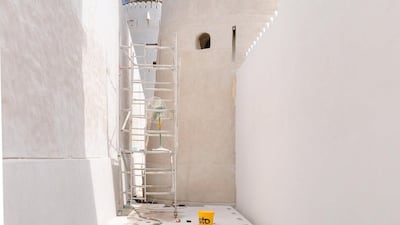The oldest standing building in Abu Dhabi will re-open to a week of festivities next month following an "immense" historical restoration project, the head of the authority behind the scheme has said.
Qasr Al Hosn will host storytelling, poetry and heritage programmes at the downtown site from December 7.
The fort has been largely closed for the past decade and the public only granted limited access during three winter festivals.
In recent years, some of the most detailed restoration and archaeological work the city has seen has been undertaken to protect the two-century-old building.
"This has been a long time coming. This is a site of history, of archaeology, of intangible heritage and a site of people – and we're going to be bringing this back to life in a matter of weeks," said Mohamed Khalifa Al Mubarak, chairman of the Department of Culture and Tourism Abu Dhabi, as he unveiled details of the launch plans on Monday.
"We are opening to the public on December 7, but it is not just one day. It is going to be a week of festivities.
"It will entail everything from poetry to storytelling – the programme is filled and the site will be full of life for the week.
"At the same time, it will be a school holiday, so it will be a major attraction for families to enjoy the beautiful weather and enjoy the fort under the stars."
The opening of Qasr Al Hosn – which is not widely known outside of the UAE, but was host to landmark moments in the country's history – will be accompanied by a major publicity drive to promote it as an essential visitor attraction.
"As far as I'm concerned, to the people of the UAE and Abu Dhabi, this is the most important cultural site at the moment because of what it says as a message," Mr Al Mubarak told The National.
"It starts as a humbling message of what the UAE and Abu Dhabi was all about and it takes you through a voyage of time and where we are today.
"We will treat this as a major international cultural site that is not only a cultural feat but an architectural feat."

Along with the fort, the Qasr Al Hosn site is also comprised of the Cultural Foundation, the popular but currently closed arts space founded in 1981 by Sheikh Zayed, and the new House of Artisans. The Cultural Foundation will host works by 25 Emirati artists who began their careers there in the first of many exhibitions.
Future visitors can expect wide ranging exhibits, from works by 1960s Arab artists to contemporary artists from South America.
In March, two more buildings will be ready – a 900-seat amphitheatre and the Abu Dhabi Children’s Library.
The Inner Fort of Qasr Al Hosn was built as a watchtower in around 1795 by the Bani Yas tribes of the Liwa Oasis settlement, who settled on Abu Dhabi island in the 1760s after discovering fresh water. The Outer Palace was built in 1939 by Sheikh Shakhbut bin Sultan and served as his majlis as well as the Al Nahyan family home during the winter months.
It continued to be used in modern times and served as the country's first debating chamber, the National Consultative Council, following the founding of the Emirates in 1971.
The rectangular site also comprised the first modern city block in Abu Dhabi and is now one of hundreds in a recognisable grid system.
"It started as a watchtower, it then evolved into a house of government and house of leadership and then moved to a house of society. So it has been in evolution, a similar evolution to what has happened here in the emirate of Abu Dhabi and the United Arab Emirates – a story of growth and a story of prosperity," said Mr Al Mubarak.
"We can all image from the windows of this fantastic fort that these leaders looked outside and imagined a different city, a city with schools, hospitals and so on."
Among the challenges in restoring the fort and the surrounding site, which was in urgent need of structural work when it closed, was to preserve the centuries-old coral and sea-stone masonry walls.
"We have spent quite a lot of time and effort in making sure we've used all of the relevant tools to make sure this building comes back to life," Mr Al Mubarak said.
Along with on-site restoration work, researchers tracked down and interviewed people who worked or lived in the fort who are still alive to create an audio history.
"The conservation work has gone to a level of detail that is world class. We have international partners who have played a big role in this.
"But I think the beauty is that the majority, if not all of the work, has been done locally by the women and men here today or are still right now working on site."
__________________
Read more:
Qasr Al Hosn to reopen after a decade on December 7
Conservation experts work to halt corrosion destroying centuries-old masonry walls of Qasr Al Hosn

























